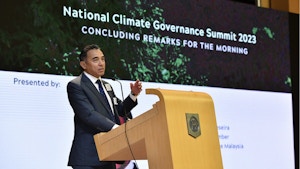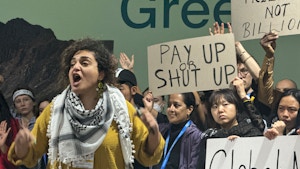With less than a month before the start of the COP29 climate talks, the Philippines is preparing to host a multi-billion dollar fund to help vulnerable nations cope with climate risks.
To continue reading, subscribe to Eco‑Business.
There's something for everyone. We offer a range of subscription plans.
- Access our stories and receive our Insights Weekly newsletter with the free EB Member plan.
- Unlock unlimited access to our content and archive with EB Circle.
- Publish your content with EB Premium.
In a hard-won battle between island states and African countries in South Korea in July, the Philippines was chosen as host of the loss and damage fund by a board created at the United Nations (UN) climate change summit in Dubai last year. The loss and damage fund is a global finance mechanism to provide compensation for losses and damages from climate-induced disasters.
Although its role as country host does not give the Philippines priority in accessing climate funds, it will allow the climate-vulnerable nation the “moral suasion” to seek contributions to the pool of money, said Mark Joven, the Southeast Asian nation’s representative to the loss and damage fund board.
This is what the Philippines has set out to do at COP29 in Baku, Azerbaijan in November, said Joven, who led the country’s bid to host the fund.
“For such an endeavor [of seeking pledges] to work, you would need to have ready access to all countries. The biggest [climate] event every year is COP, where a lot of leaders will be. It will make pledging somewhat easier for the Philippines,” Joven, a former undersecretary of finance, told Eco-Business.
“
There is no commitment from the Philippine government to actually put money into the fund. But by virtue of being the host, it’s critical for us to muster financial resources from partner countries in order to ratchet up the loss and damage fund.
Mark Joven, Philippine representative, loss and damage fund board
As of last year’s climate summit in Dubai, wealthy countries most responsible for the climate emergency have pledged a combined total of more than US$700 million to the fund, which has not been added to since then. That financial outlay is the equivalent of less than 0.2 per cent of the irreversible economic and non-economic losses developing countries are facing from global heating every year.
Joven, a law professor at the University of the Philippines and currently a fellow for public administration at Harvard University, speaks to Eco-Business in an exclusive interview about his hopes for a fund that aims to help countries most vulnerable to climate change.
What is expected of the Philippines as country host to the loss and damage fund board at COP29?
There is no commitment from the Philippine government to actually put money into the fund. But by virtue of being the host, it’s critical for us to muster financial resources from partner countries in order to ratchet up the loss and damage fund. On the global stage, the Philippines has a lot of influence to ask governments to put in some token amount. It will be a good signal for a particularly vulnerable middle-income country like the Philippines to symbolically provide money by convincing other like-minded countries to put in funds, which will hopefully snowball into a more meaningful loss and damage fund. Obviously right now, it’s not meaningful.
Apart from soliciting pledges for the fund, does the function of country host remain logistical and secretarial in nature for future board meetings?
Yes. The funding decisions provided by the loss and damage fund are determined by its board of directors, not the host. The Philippines will not always have a representative on the loss and damage fund board. At some point we will be rotated out of it because there are only 26 members in the world, and there are only 26 directors. In so far as active or heavy handed intervention goes, that’s something that our government cannot do.
What ideas does the board have to stretch the US$700 million loss and damage fund?
You can go from the least ambitious to the most ambitious. The least is the plain garden variety bilateral donations from developing countries. Then you move towards the right of the spectrum, into cooperation projects with multilateral development banks, then you might consider partnerships with big non-government organisations like the Gates Foundation or Bloomberg Foundation. In the far right of the spectrum, you have a global system which demands setting aside money from high-emitting industries. For example, there have been proposals to get part of the money from shipping or air travel. That’s the spectrum of possibilities in so far as fundraising is concerned.
Loss and damage, as one of the three pillars of climate finance, is still not part of the new climate finance goal based on the high level meetings in Baku ahead of COP29. What happens if it will be excluded from the new collective quantified goal (NCQG) scope during the November negotiations?
I don’t think [it will be excluded from the NCQG]. COP27 set up the fund and it was operationalised in Dubai last year, so it already exists.The primordial question here is, how ambitious will the loss and damage agenda be?
The global requirement for annual loss and damage is around US$300 billion by 2030, so if the amount called for is US$1 trillion, then loss and damage should account for a third of it, divided equally between adaptation and mitigation.
But then again, how can we demand for US$1 trillion when the US$100 billion agreement has not even been produced yet? [Poor countries were promised US$100 billion a year in climate finance by 2020 by developed country governments more than a decade ago. Rich countries missed the longstanding pledge but claimed to have achieved it in 2022.]
If we were going to increase the global requirement for climate finance to US$1 trillion, there are only a few ways to go about it – countries accept in principle, and then come implementation time, we encounter problems or countries just reject it outright.

Metro Manila’s business district contrasts with a slum area. The loss and damage board meeting will be held for the first time in the Philippine capital on the first week of December 2024. It will be the last meeting of the board for the year, following sessions in the United Arab Emirates, South Korea and Azerbaijan. Image: Jannie Lou Trijo
Can you tell us more about the “small-grants window” that is set to be implemented in the fund, and how this differs from other UN climate funding mechanisms like Green Climate Fund (GCF)?
Having a small grants window in the loss and damage fund means the money’s audit process is truncated or simplified. Smaller countries have direct access to funds, without going through accredited entities (like development banks or government department), which the GCF does not have.
Traditional accreditation methods like the GCF’s means that for each project to be implemented, you’ll have to go through the World Bank, ADB or UNICEF, which costs money.
The loss and damage fund will also have budget support where a loan will be given directly to the government and then deployed for a project. Unlike GCF projects, we cannot wait for a concept note for the funds for reconstruction to be approved and implemented for a typhoon.
What are the advantages of the Philippines hosting the loss and damage fun rather than small island developing states (SIDS) or African countries, which also bid to be country host?
Both the Philippines and SIDS are particularly vulnerable countries, but what differentiates us is the demographics in the economy. The populations of SIDS is sub 1 million people. The Philippines, on the other hand, is at least 100 times bigger in terms of population and several magnitudes bigger in terms of geography.
As the host country, it means we are allowed the opportunity to point the spotlight to bigger countries facing loss and damage problems, not just the Philippines. Countries like Pakistan and Bangladesh which even have bigger populations than the Philippines suffer significantly from flooding and heavy volume rain storms, which drastically affects their economies.
As for African least developed countries, the difference between us and them is the population. They have big tracts of land but the population is relatively sparse. Our unique character is that we have the opportunity to show the world how much is needed to make the loss and damage fund work. If a state with a small population was the host, showing the plight of countries affected by loss and damage will be less effective.
What are the disadvantages of the Philippines being country host?
It would not be practical for the Philippines to have pure grants [in receving the loss and damage funds].
SIDS and least developed countries insist on pure grants as a financing modality. But when you deal with bigger countries like the Philippines, Pakistan, and Bangladesh, we have a capital market system, which we’ve developed where we can borrow money at a reasonable interest rate in order to fund our effort.
In that sense, we need the money less than they do, so it can be a disadvantage. But it can be an advantage because we can blend money – government gets financing from the international capital markets and blends it with the amount provided by the loss and damage fund in order to implement or deploy the money to affected people.
What excites you the most about the Philippines playing host to the loss and damage fund board?
We get a better view of where [the funds] are going. The problem with the United Nations Framework Convention on Climate Change is that they’re a small organisation, such that sometimes they do not effectively communicate where the funds are going. For example, have you heard of the projects of the adaptation fund? Likely no. If the board was hosted in some other country, the likelihood of us understanding what is believed in this space is very low because they don’t have the capability to circulate what is being done.














